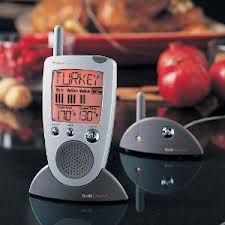You have baked the turkey according to the recipe, you pull the turkey out and when you carve it you find some pink turkey near the bone. Is it safe? Are you going to get salmonella? Should you throw it away, not eat it, re-heat it?

The answer is: MAYBE.
The safest way to check a turkey is with a meat thermometer. The color is not a sign of whether the turkey is “done,” and in fact, pink turkey may be quite safe. Hopefully, instead of following a time/temperature chart for your holiday feast you used a meat thermometer. Turkey can appear pink even up to 175 degrees F, which is well above anyone’s recommended temperatures for safety (and beyond dry for turkey). So if you have used a meat thermometer, and used it properly by inserting it into the deepest part of the turkey breast, and the turkey was 145 degrees when you took it out of the oven, and it rested on the counter for at least 20 minutes- then your turkey is going to be fine.
To kill bacteria we need two things: temperature and time. You can see that the hotter the temperature, the less time it takes to kill bacteria.
| Min Internal Temp F | 6.5 log lethality | 7.0 log lethality |
| 130 F | 112 min | 121 min |
| 135 F | 36 min | 37 min |
| 140 F | 12 min | 12 min |
| 145 F | 4 min | 4 min |
| 150 F | 67 seconds | 72 seconds |
The 6.5 log lethality means you are killing 99.99997 percent of the bugs (also called 6.5D) . A 7D lethality means you are killing 99.9999999 per cent of the bugs. If you have highly contaminated poultry (37,500 bacteria per gram of raw meat) then 3.5 ounces of meat would have 5.4 million Salmonella. To drop 7D means you would reduce 10 million pathogens to one bug. It takes about 105 Salmonella per gram of food to cause illness, less Salmonella than that cause no clinical symptoms. Thus, with worst case scenario you could kill just 99.999 per cent of the bacteria and not have symptoms (a 5D reduction).
Salmonella is uncommon with US produced turkeys. The main issue is Campylobacter not salmonella. But a big is a bug.
Why is the turkey pink?
Inside the muscle of the turkey (like the breast, thighs, drumsticks) are proteins that contain iron (myoglobin is their names). These iron molecules turn brighter red with chemicals given off by the stove, or the grill. In fact, if you smoke a chicken or a turkey, or any meat, you will see what the bbq crowd calls a “smoke ring”. That is simply the color change in the iron containing proteins to the smoke (carbon monoxide). Since the meat of chicken is fairly light, it is easy to see this color. Other things that change the color are nitrates
This color will fade away as the protein breaks down with more heat, although you will see this color with any BBQ turkey, or any BBQ meat. BBQ types call this the smoke ring.
There are other chemicals that change those colors- such as nitrates.
The Turkey is pink- What to do?
But if you have used a meat thermometer, rested the turkey properly – then pink color can be quite normal.
Of course, if you had used Sous Vide, you can be assured that the turkey will be perfect.
HERE IS WHAT NOT TO WORRY ABOUT:
The rest of the meat is not contaminated. Bugs don’t reproduce above 113 degrees F (which is why your body produces a fever, to inhibit the bacteria from reproducing- our bodies can’t have much of a fever, but the fever does inhibit bacterial reproduction). So while part of the turkey may be pink, this does NOT mean that the turkey is contaminated with bacteria. So, you dont need to worry about the non pink parts.
Reheating the turkey?
So you have this pink turkey and you want to know what to do with it.
First, relax, to heat it where your know-it-all uncle will enjoy it will only take a few minutes.
Put a sauce pan on the stove to medium heat. When it is hot (about a minute) add oil to the pan.
Carve the turkey per your routine. One tip: the non-pink turkey is fine, so don’t worry about cross contamination here.
Put the pink pieces into the sauce pan, after 90 seconds turn. This works with all parts of the turkey – so if you have a drum stick you are worried about use it

Using a quick fry on the oven will also give you a quick crisp to the skin if you have larger pieces that you are worried about
The pink turkey is done now- and still moist. You have saved Thanksgiving
Pour yourself a glass of wine, and enjoy the time with your guests
References:
This article shows the temperature curve for reproduction of various bacteria. What you will see is that pathologic bacteria do not reproduce above 113 degrees F (45 degrees C)
Evolution. 2001 Jan;55(1):33-40. Evolutionary adaptation to temperature. VIII. Effects of temperature on growth rate in natural isolates of Escherichia coli and Salmonella enterica from different thermal environments. Bronikowski AM, Bennett AF, Lenski RE. Pub Med ID 11263744
Thankfully there is a trend among younger cooks to use a food thermometer, while people older do not. My one recommendation is if you are cooking , get a food thermometer, do not leave it to chance.
Trends in ownership and usage of food thermometers in the United States, 1998 through 2010.J Food Prot. 2012 Mar;75(3):556-62.Lando AM, Chen CC.






No Responses to “EAT? Pink Turkey: Is it safe?”